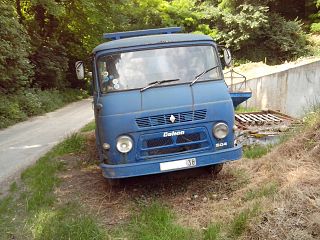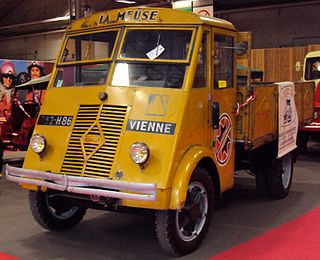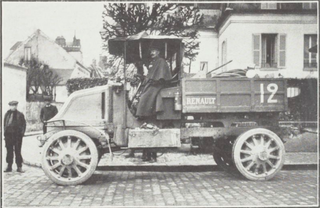
Commer was a British manufacturer of commercial vehicles from 1905 until 1979. Commer vehicles included car-derived vans, light vans, medium to heavy commercial trucks, military vehicles and buses. The company also designed and built some of its own diesel engines for its heavy commercial vehicles.

The Mazda Bongo, also known as Mazda E-Series, Mazda Access, and the Ford Econovan, is a cabover van and pickup truck manufactured by the Japanese automobile manufacturer Mazda since 1966. It has been built with rear-, middle-, as well as front-mounted engines. It also formed the basis for the long running Kia Bongo range. It is named for the African Bongo, a type of antelope.

The Renault Master is a large van produced by the French manufacturer Renault since 1980, now in its third generation. It replaced the earlier Saviem SG3 light trucks. Opel has sold versions of the second and third series vans as the Opel Movano in Continental Europe and Vauxhall Movano in the United Kingdom. All three generations have been designed and manufactured by Renault, irrespective of the brand.

The Mercedes-Benz Atego is a range of general-purpose rigid trucks introduced by Mercedes-Benz in 1998. A new model was introduced in 2004, followed by a facelift in 2010 and another new model in 2013. The latest version is available in gross vehicle weights of 6.5 to 16 metric tonnes (t) and is powered by a straight 4- or 6-cylinder engine.

The Volkswagen Taro 1 tonne pickup truck was introduced in January 1989 by Volkswagen Commercial Vehicles to complement the half tonne Caddy pickup / panel van ranges, and the 1 tonne Transporter van and chassis cab ranges. The name "tarō" is a suffix used in Japanese to denote the oldest brother or son, or the first-born son of a family.
The World Series Formula V8 3.5, formerly the World Series by Nissan from 1998 to 2004, the Formula Renault 3.5 Series from 2005 to 2015 and the Formula V8 3.5 in 2016 and 2017, was a motor racing series promoted by RPM Racing and Renault Sport.

The Toyota Dyna is a medium-duty cab over truck for commercial use. In the Japanese market, the Dyna is sold alongside its twin called the Toyoace. The Toyoace was a renaming of the Toyopet SKB Truck as a result of a 1956 public competition with 200,000 entries. "Dyna" is short for dynamic.
The Lancia Ro, Lancia Ro-Ro and Lancia 3Ro were 4x2 heavy trucks built by Italian manufacturer Lancia from the 1930s through the 1940s for military and civilian use. The 2-cylinder diesel Ro was produced from 1933 to 1939, the 3-cylinder diesel Ro-Ro from 1935 to 1939 and the improved 5-cylinder diesel 3Ro from 1938 to 1947.
The SM Europe was a range of medium/heavy trucks manufactured by the French company Saviem.

The Saviem Super Galion is a truck under 6 tonnes gross vehicle weight (GVW) produced by the French manufacturer Saviem between 1965 and 1982. It was also marketed as the Renault Super Galion.

The Renault 2,500 kg and the Renault Galion were truck/vans with a 2.5-tonne carrying capacity manufactured by Renault between 1947 and 1957 and then by its subsidiary Saviem between 1957 and 1965.

The Renault AHx was a range of light/medium trucks with carrying capacities from 2 to 5 tonnes manufactured by Renault between 1941 and 1947. Various versions were used in World War II by the German forces.
The Panhard K 101 is a forward control truck aimed at military and commercial use produced between 1937 and 1940 by the French manufacturer Panhard.

The Tracteur Panhard-Châtillon (French pronunciation: [tʁaktœʁ panaʁ ʃatijɔ̃ ] was a conventional-cabin, all-wheel drive truck produced between 1911 and 1918 by the French manufacturer Panhard. It was one of the first all-wheel drive trucks used by the French military.

The Renault EG is an all-wheel drive truck/artillery tractor produced between 1914 and 1919 by the French manufacturer Renault.
The Renault AGx was a range of light/medium/heavy trucks produced by the French manufacturer Renault between 1937 and 1941. The range includes both conventional and forward control trucks.

The Renault PN is a bus produced from 1926 until 1930 by the French manufacturer Renault for the Paris service. A variant for suburban transport was called Renault PY.
The Saviem S is a range of medium-duty trucks manufactured by the French manufacturer Saviem between 1964 and 1967.

The early 1930s Renault commercial vehicles were a range of modular chassis produced by Renault, sold under various configurations, primarily trucks, buses and coaches. The range was the first from Renault to get diesel engines and it abandoned previous design styles from the company. The range was gradually replaced from 1935 onwards by the ACx and ADx light range, the ABx medium range and the ZP bus/coach.

The Renault ABx is a range of medium-duty forward control trucks produced by Renault between 1934 and 1937. The range was made of the ABF and the ABG. Renault also developed a bus/coach called the ZP using the same cabin.















